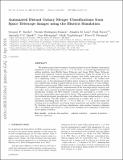| dc.contributor.author | Snyder, Gregory F | |
| dc.contributor.author | Rodriguez-Gomez, Vicente | |
| dc.contributor.author | Lotz, Jennifer M | |
| dc.contributor.author | Torrey, Paul A. | |
| dc.contributor.author | Quirk, Amanda CN | |
| dc.contributor.author | Hernquist, Lars | |
| dc.contributor.author | Vogelsberger, Mark | |
| dc.contributor.author | Freeman, Peter E | |
| dc.date.accessioned | 2022-08-02T15:08:56Z | |
| dc.date.available | 2021-09-20T18:22:53Z | |
| dc.date.available | 2022-08-02T15:08:56Z | |
| dc.date.issued | 2019 | |
| dc.identifier.uri | https://hdl.handle.net/1721.1/132530.2 | |
| dc.description.abstract | © 2019 The Author(s) Published by Oxford University Press on behalf of the Royal Astronomical Society. We present image-based evolution of galaxy mergers from the Illustris cosmological simulation at 12 time-steps over 0.5 < z < 5. To do so, we created approximately one million synthetic deep Hubble Space Telescope and James Webb Space Telescope images and measured common morphological indicators. Using the merger tree, we assess methods to observationally select mergers with stellar mass ratios as low as 10:1 completing within ±250 Myr of the mock observation. We confirm that common one-or two-dimensional statistics select mergers so defined with low purity and completeness, leading to high statistical errors. As an alternative, we train redshift-dependent random forests (RFs) based on 5-10 inputs. Cross-validation shows the RFs yield superior, yet still imperfect, measurements of the late-stage merger fraction, and they select more mergers in bulge-dominated galaxies. When applied to CANDELS morphology catalogues, the RFs estimate a merger rate increasing to at least z = 3, albeit two times higher than expected by theory. This suggests possible mismatches in the feedback-determined morphologies, but affirms the basic understanding of galaxy merger evolution. The RFs achieve completeness of roughly $70 $ at 0.5 < z < 3, and purity increasing from $10 $ at z = 0.5-60 per cent at z = 3. At earlier times, the training sets are insufficient, motivating larger simulations and smaller time sampling. By blending large surveys and large simulations, such machine learning techniques offer a promising opportunity to teach us the strengths and weaknesses of inferences about galaxy evolution. | en_US |
| dc.language.iso | en | |
| dc.publisher | Oxford University Press (OUP) | en_US |
| dc.relation.isversionof | 10.1093/MNRAS/STZ1059 | en_US |
| dc.rights | Creative Commons Attribution-Noncommercial-Share Alike | en_US |
| dc.rights.uri | http://creativecommons.org/licenses/by-nc-sa/4.0/ | en_US |
| dc.source | arXiv | en_US |
| dc.title | Automated distant galaxy merger classifications from Space Telescope images using the Illustris simulation | en_US |
| dc.type | Article | en_US |
| dc.contributor.department | Massachusetts Institute of Technology. Department of Physics | en_US |
| dc.contributor.department | MIT Kavli Institute for Astrophysics and Space Research | en_US |
| dc.relation.journal | Monthly Notices of the Royal Astronomical Society | en_US |
| dc.eprint.version | Author's final manuscript | en_US |
| dc.type.uri | http://purl.org/eprint/type/JournalArticle | en_US |
| eprint.status | http://purl.org/eprint/status/PeerReviewed | en_US |
| dc.date.updated | 2020-11-12T16:40:28Z | |
| dspace.orderedauthors | Snyder, GF; Rodriguez-Gomez, V; Lotz, JM; Torrey, P; Quirk, ACN; Hernquist, L; Vogelsberger, M; Freeman, PE | en_US |
| dspace.date.submission | 2020-11-12T16:40:37Z | |
| mit.journal.volume | 486 | en_US |
| mit.journal.issue | 3 | en_US |
| mit.license | OPEN_ACCESS_POLICY | |
| mit.metadata.status | Publication Information Needed | en_US |
